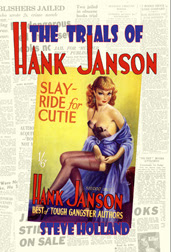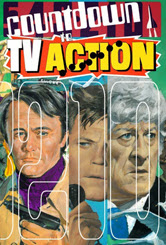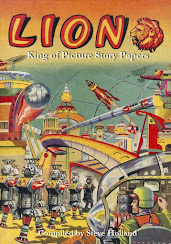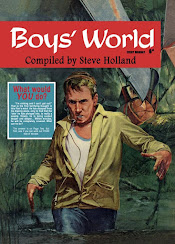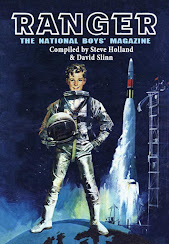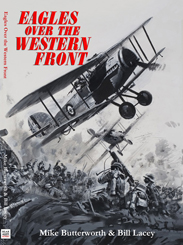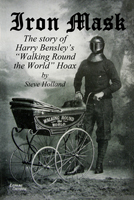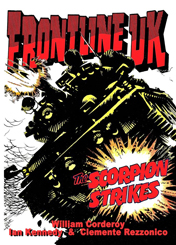Full credit to my mate John Herrington for the following discovery. In Al Hubin's Crime Fiction Bibliography there is a short entry for one John H. Duos, who wrote a couple of paperback originals shortly after the First World War but was primarily listed for a collection of a dozen crime stories entitled The Order of the Cross, published in 1903.
John spotted an entry in death records for a John H. C. D. Duos, who died in 1941 in Plymouth, Devon, aged 57.
As John Harold Duos, he contributed to The Star as early as 1898 with the story 'An Introduction to Venus' (23 May 1898) and made a further two contributions in 1899-1900 as John H. Duos. A search of other newspaper resources led to the discovery of many more stories, including a number of serials, at least some of which were later reprinted as paperbacks, including The Silver Crucifix and The Prettiest Girl in London. It would appear that John H. Duos had a far more extensive writing career than we were giving him credit.
John Harold Duos is to be found renting rooms at 6 Culverley Cresent, Catford, in 1912 and 125 Inchmery Road, Lewisham, in 1913-15.
However, a search of census records shows that in 1911, 6 Culverley Crescent was occupied by 69-year-old widow Matilda Cairns and her son, 34-year-old author and journalist John Cairns. It isn't a great step to prove that Cairns was behind the pen-name John H. Duos as his death in 1941 was also registered as John H. C. D. Cairns.
His origins are rather more tricky to trace. A death at age 57 would imply he was born in 1883 or 1884. The 1911 census gives his place of birth as Bermondsey, London, and both Mathilda (sic) and John Cairns are to be found in earlier census records which give John's birth as 1875/76 or 1876/77.
In 1881, aged 5, he was living with his parents, Scottish-born John (an engine fitter) and Mathilda (born in Lyons, France, of British parents) and younger brother Robert (born in Bermondsey 9 months earlier in 1880), at 7 Mossington Road, Rotherhithe, Southwark. By 1891 the family were living at Abbeyfield Road, Rotherhithe, and 14-year-old John was working as a leather strap cutter.
By 1901, 25-year-old John S. Cairns (sic) was still living with his mother at 312 Lynton Road, Bermondsey, but was now described as an author, journalist and dramatic critic.
The middle initial helps establish Cairns' birth, which was registered in 2Q 1876 in St. Olave, Bermondsey. He was baptized John Samuel Caldwell Cairns at St. James, Bermondsey, on 30 July 1876.
His parents were John Weir Cairns who was married to Matilda Caldwell in St. Saviour, Southwark, in 1863. John Weir Cairns died in St. Olave, Southwark, in 1907, aged 71, and Mathilde (sic) Cairns died in Lewisham in 1914, aged 73.
In 1913, John H. Duos was described as "a well-known comedy playright and dramatic critic", although I can find no entry for him in Stage Yearbook, nor any trace of published plays.
In 1917, Duos became embroiled in a court case relating to a dispute over a magazine competition. The case, Barrett v. John Bull (Limited) was heard before Mr Justice Darling and a special jury and involved a £1,000 prize. This was offered by John Bull to anyone who could prove that their "'Bullet' competition" was not properly conducted.
Unfortunately, I have not been able to track down full details of the outcome of the case but the facts, as given by the defendants, are that the action was brought by a discharged servant of John Bull in relation to what was known as the 'Bullet' competition in which a phrase was given and contestants had to create a witty sentence of not more than four words which had some bearing on the phrase. For example, "Church Parade" was one of the phrases and the prize-winner's sentence was "Congregation Nodding."
Other examples, described in court as "equally amusing," included "Raw Recruit" ("Salutes cinema attendant!"), "When the honeymoon is over" ("Proposer becomes seconder"), "In great demand" ("Restitution of convivial nights"), "The British Navy" ("Does not sink to murder") and "The Kaiser's future" ("Won't rest with the clergy")—"And a good thing for him," added Mr. Justice Darling to general laughter.
Three former judges of the competition were to have been called as witnesses by the plaintiff but had not been served with subpoenas issued a month earlier despite every effort being made. The three journalists included Mr. Percy Douglas, who was also a member of the Bar and employed by the Board of Trade. On half a dozen occasions when called upon at the Board of Trade, it was said that Douglas was away on leave, yet when his residence was visited the plaintiff's solicitors, he was said to be at the Board of Trade.
The second named witness was John H. Duos "who was working under an assumed name." Douglas, Duos and a third man had all been judges of the competition and were paid for their work. Shortly before the £1,000 prize competition, they resigned and set up in business as "professional solutionists" offering to supply competitors with witty sentences at a price; those who bought them were to agree to pay a commission on the prizes won. In the circulars set out, mention was made that they had three years' experience of judging the competition.
The plaintiff alleged that the competition was not fairly conducted and that the three "solutionists" had made statutory declarations to that effect. Subsequently, the defendants received a letter from one of the three apologizing and withdrawing the allegation which he made.
When the case came before the King's Bench Division on 25 April 1917, Mr. Percy Oliver, for the plaintiff, asked that the case be postponed until his witnesses could be tracked down. Mr. Justice Darling responded by saying that "this was a question of a statutory declaration, and a man can be prosecuted for a false statement. The Public Prosecutor may want to know about this case if false statements have been made on oath, and in any case one of the men is a barrister, and the Benchers of his Inn would take notice of it. The case must be postponed until the next sittings.
"A grave charge was made against a newspaper of dishonest conduct, and it had been supported by three persons, all journalists, one of them also a barrister, who had made statutory declarations ... They might realize that if they had made statutory declarations which were not true it was a criminal offense. For anybody to do that was a serious matter, and for a barrister even to be suspected of it was very serious. After what had been said publicly in Court they would see that the alternative to accepting subpoenas and attending as witnesses to support their statutory declarations might be an appearance at a Police Court on a charge of making a false declaration."
His Lordship concluded that he was satisfied that there had been an attempt here to frustrate justice... but it would not succeed!
What happened next is something of a mystery. John H. Duos continued to write, although his publishers in the paperback field were not the best payers. The "My Pocket" 3d Novels series published by Hornsey Journal included at least one novel under the byline John H. Dunette, which may be another pseudonym. A third may be John Duno, under which byline appeared For the Cup and a Wife (Hornsey Journal FP Racing Novels 70, July 1930); if the John H. Dunette byline has a question mark over it, Duno might perhaps have two.
In 1939, Duos was living at 42 Ker Street, Devonport, Plymouth, with his wife. John S. C. Cairns had married Lilian A. Amey in Devonport in 1920. The 1939 Register gives his occupation as commercial traveller and his date of birth as 25 April 1884.
Duos, as Cairns was widely known, probably continued to write until his death in 1941, aged 64 rather than the reported 57.
PUBLICATIONS
Novels
The Silver Crucifix. London, Aldine Publications (Mascot Novels 108), 1919.
The Convict Woman. London, Aldine Publications (Mascot Novels 111), 1919.
Hearts and Swords. London, Aldine Publications (Mascot Novels 120), 1919.
The Prettiest Girl in London. Aldine Publications (Mascot Novels 126), 1920.
Finding Love (as by John H. Dunette). Hornsey Journal (My Pocket 3d Novels 161), May 1928.
A Girl's Luck. Hornsey Journal (My Pocket 3d Novels 162), May 1928.
Collections
The Order of the Cross, and other detective stories. London, R. A. Everett & Co., 1903.
Short Stories & Serials
The Folly of Kate Millmay (as John Harold Duos, Chicago Daily Tribune, 10 Dec 1896; Winnipeg Free Press, 15 Jan 1897)
An Introduction to Venus (as John Harold Duos, The Star, 23 May 1898)
At the Penitent Form (The Star, 2 Oct 1899)
The Wholesale Liar (The Star, 30 May 1900)
The Mysterious Millionaire
The Terror of the Skies
The Vengeance of Leslie Drummond
A Society Sinner (serial, Lincoln Gazette, circa Oct/Dec 1907; Portsmouth Evening News, circa Jul/Aug 1908)
The Ruling Passion (serial, Bury Times, circa Oct 1909/Jan 1910; Lincolnshire Echo, circa May 1910)
A Mayfair Mystery
The Way of the World
The Secret Seven
The Mystery of the Runcorn Inheritance
Love Conquers All (serial, Northampton Mercury, 28 Jul 1911-circa Sep 1911)
Roger Wagnall's Ghost (Burnley News, 18 Dec 1912)
The Faithful Five (serial, The Bristol Observer, circa Apr 1913; New Zealand Herald, 25 Oct 1913-?)
Accidental Chapters
Points of View
Old Mr. Giffard's Will (The Bristol Observer, 28 Feb 1914; Tamworth Herald, 31 Oct 1914)
The Silver Crucifix
The Furnace of Affliction (serial, Biggleswade Chronicle, circa Jun/Jul 1917)
The Prettiest Girl in London
Doubleday's Double
The Revolutionist: A Story of a South American Republic (Taunton Courier, 28 Aug 1918)
The Girl with the Sea-Green Eyes (Framlingham Weekly News, 1 Aug 1931)
Saturday, January 31, 2015
Friday, January 30, 2015
Comic Cuts - 30 January 2015
I can't believe it's the end of the month already. A twelfth of the way through the year. Under 100 days to the election in May. Another year older come April.
Hopefully, a new book out next month. I've now settled on a title, so I'm pleased to announce that the next book from Bear Alley Books will be...
This is the project I have been working on since before Christmas. The book will gather up a lot of previously little-seen illustrative artwork from the pages of Look and Learn, Bible Story, Ranger, World of Wonder and Once Upon a Time, including Lawrence's magnificent 'Herod the Great' strip from Bible Story, the serials 'The Range Rider' (Ranger), 'Pinnocchio' and 'Jason and the Golden Fleece' (both Once Upon a Time) in full, and scarce illustrations from various weeklies and annuals. In colour.
The cover is a piece originally painted for Bible Story which has only appeared in a limited edition book in the Netherlands; I haven't quite finished it, so that will have to wait before it's revealed.
I reported last week that I was writing the introductory material. Well, I still am. It is my intention to cover the whole of Don's career in the introduction so that the illustrations in the book will have some context. Tucked away on my hard drive was an unpublished piece about Don written shortly after his death that did much of the groundwork. This I've expanded greatly—it is already doubled in length and I've only reach the 1960s!—and it will be woven through the book.
But I thought I'd take a break from the writing and spend Wednesday coming up with some ideas on how the book should look. I roughed out a couple of pages and a title page and cover and the signature above will be a running theme through the design of the book. (Well, that's the plan at the moment... it might change as I get into the layouts!)
Today's random scans are a quartet of covers by Ed Mortelmans, who is probably better known for his work with Four Square. These are all from Panther in the 1950s.
While I'm working on layouts, the Bear Alley blog may have to take a back seat. I do have more World of Wonder galleries, but we will just have to see what happens over the weekend.
Hopefully, a new book out next month. I've now settled on a title, so I'm pleased to announce that the next book from Bear Alley Books will be...
This is the project I have been working on since before Christmas. The book will gather up a lot of previously little-seen illustrative artwork from the pages of Look and Learn, Bible Story, Ranger, World of Wonder and Once Upon a Time, including Lawrence's magnificent 'Herod the Great' strip from Bible Story, the serials 'The Range Rider' (Ranger), 'Pinnocchio' and 'Jason and the Golden Fleece' (both Once Upon a Time) in full, and scarce illustrations from various weeklies and annuals. In colour.
The cover is a piece originally painted for Bible Story which has only appeared in a limited edition book in the Netherlands; I haven't quite finished it, so that will have to wait before it's revealed.
I reported last week that I was writing the introductory material. Well, I still am. It is my intention to cover the whole of Don's career in the introduction so that the illustrations in the book will have some context. Tucked away on my hard drive was an unpublished piece about Don written shortly after his death that did much of the groundwork. This I've expanded greatly—it is already doubled in length and I've only reach the 1960s!—and it will be woven through the book.
But I thought I'd take a break from the writing and spend Wednesday coming up with some ideas on how the book should look. I roughed out a couple of pages and a title page and cover and the signature above will be a running theme through the design of the book. (Well, that's the plan at the moment... it might change as I get into the layouts!)
Today's random scans are a quartet of covers by Ed Mortelmans, who is probably better known for his work with Four Square. These are all from Panther in the 1950s.
While I'm working on layouts, the Bear Alley blog may have to take a back seat. I do have more World of Wonder galleries, but we will just have to see what happens over the weekend.
Thursday, January 29, 2015
Commando issues 4779-4782
Commando issues on sale 29th January 2015.
Commando No 4779 – Evil In The East
The jungle can be a hostile place, besides the strength-sapping heat and humidity, dangerous animals and plants abound.
This counts double if you’re a confirmed coward, born and raised in London, separated from your comrades and being pursued by a deadly assassin.
That was the position that “Jelly” Jakes of the Convict Commandos found himself in. let’s be honest, he had every right to be terrified.
Story: Alan Hebden
Art: Manuel Benet
Cover: Manuel Benet
Commando No 4780 – Fighting Fury
He was only a skinny little guy, about five feet nothing at all…but, by jiminy, any Nazis who ran up against Private Sam Small were out of luck.
While his ammo lasted, Sam shot them; then with his empty gun he clubbed them; when it was in splinters, he started in with his bare hands!
Only one man knew what drove that little guy to such a fighting fury — only one found out the terrible secret of Sam Small — and here he tells Sam’s amazing story.
Introduction
Hiding behind Aldoma’s magnificent all-action cover is one of the most idiosyncratic Commando stories you’ll ever read. Told in the first person, and an American first person at that, it chronicles the acts of a man with a death wish over a very short period of time. These are traits not normally associated with Commando and, indeed, very difficult to get right. But right they are here, very right indeed.
Sit back, suspend your disbelief and enjoy this roller-coaster ride in the thick of the action in the company of ace reporter Jim Dawson.
By the way, we had noticed Jim’s similarity to Robert Mitchum.—Calum Laird, Commando Editor
Story: Wilding
Art: Martin [Salvador]
Cover: Aldoma
Originally Commando No 159 (April 1965); re-issued as No 747 (June 1973).
Commando No 4781 – D-Day Dodgers
In 1944 someone named the servicemen in Italy the D-Day Dodgers; as though somehow the war they were fighting was a cushy number compared to the battles in France. Outraged, one national newspaper decided to expose these loafers once and for all.
That’s how reporter Perry Potter and his photographer Chalky White came to be standing on a freezing airfield in “sunny” Italy. The weather was just the first of the eye-openers the pair was going to see.
Story: Alan Hebden
Art: Vicente Alcazar
Cover: Ian Kennedy
Commando No 4782 – Tempest Fury
In the summer of 1944, a frightening new weapon was unleashed against the war-weary British — the dreaded V1 flying bomb.
Sergeant-Pilot Jamie Collins had a personal score to settle with these robots of death. So when his squadron-leader grounded him after yet another display of reckless flying, it didn’t stop him.
Where there were V1s, that’s where Jamie wanted to be, at the controls of his hard-hitting tempest fighter. Orders or no orders…
Introduction
Scott the Deputy Ed is on holiday so I get to write the intro to this story from our 25-year-old collection. Growing up with Commando in the 60s there were no creator credits on the books but there was one inside artist whose style stood out. Very individual, angular, with strong, strong blacks and peppered with skilfully-employed Zip-A-Tone — the sheets of dots which provide shading. To me the style looked just right for Commando. His name? Gordon Livingstone.
I still think that, which is why you’re getting another chance (or a first chance) to read Ken Gentry’s crackling air/ground story and marvel at the magnificent economy of composition that is Ian Kennedy’s cover — there’s nothing there that doesn’t have to be.
This really is a mini-masterpiece. Should I let Scott read it?—Calum Laird, Editor
Story: Ken Gentry
Art: Gordon Livingstone
Cover: Ian Kennedy
Originally published as Commando No 1092, (January 1977); re-issued as No 2420 (November 1990).
Commando No 4779 – Evil In The East
The jungle can be a hostile place, besides the strength-sapping heat and humidity, dangerous animals and plants abound.
This counts double if you’re a confirmed coward, born and raised in London, separated from your comrades and being pursued by a deadly assassin.
That was the position that “Jelly” Jakes of the Convict Commandos found himself in. let’s be honest, he had every right to be terrified.
Story: Alan Hebden
Art: Manuel Benet
Cover: Manuel Benet
Commando No 4780 – Fighting Fury
He was only a skinny little guy, about five feet nothing at all…but, by jiminy, any Nazis who ran up against Private Sam Small were out of luck.
While his ammo lasted, Sam shot them; then with his empty gun he clubbed them; when it was in splinters, he started in with his bare hands!
Only one man knew what drove that little guy to such a fighting fury — only one found out the terrible secret of Sam Small — and here he tells Sam’s amazing story.
Introduction
Hiding behind Aldoma’s magnificent all-action cover is one of the most idiosyncratic Commando stories you’ll ever read. Told in the first person, and an American first person at that, it chronicles the acts of a man with a death wish over a very short period of time. These are traits not normally associated with Commando and, indeed, very difficult to get right. But right they are here, very right indeed.
Sit back, suspend your disbelief and enjoy this roller-coaster ride in the thick of the action in the company of ace reporter Jim Dawson.
By the way, we had noticed Jim’s similarity to Robert Mitchum.—Calum Laird, Commando Editor
Story: Wilding
Art: Martin [Salvador]
Cover: Aldoma
Originally Commando No 159 (April 1965); re-issued as No 747 (June 1973).
Commando No 4781 – D-Day Dodgers
In 1944 someone named the servicemen in Italy the D-Day Dodgers; as though somehow the war they were fighting was a cushy number compared to the battles in France. Outraged, one national newspaper decided to expose these loafers once and for all.
That’s how reporter Perry Potter and his photographer Chalky White came to be standing on a freezing airfield in “sunny” Italy. The weather was just the first of the eye-openers the pair was going to see.
Story: Alan Hebden
Art: Vicente Alcazar
Cover: Ian Kennedy
Commando No 4782 – Tempest Fury
In the summer of 1944, a frightening new weapon was unleashed against the war-weary British — the dreaded V1 flying bomb.
Sergeant-Pilot Jamie Collins had a personal score to settle with these robots of death. So when his squadron-leader grounded him after yet another display of reckless flying, it didn’t stop him.
Where there were V1s, that’s where Jamie wanted to be, at the controls of his hard-hitting tempest fighter. Orders or no orders…
Introduction
Scott the Deputy Ed is on holiday so I get to write the intro to this story from our 25-year-old collection. Growing up with Commando in the 60s there were no creator credits on the books but there was one inside artist whose style stood out. Very individual, angular, with strong, strong blacks and peppered with skilfully-employed Zip-A-Tone — the sheets of dots which provide shading. To me the style looked just right for Commando. His name? Gordon Livingstone.
I still think that, which is why you’re getting another chance (or a first chance) to read Ken Gentry’s crackling air/ground story and marvel at the magnificent economy of composition that is Ian Kennedy’s cover — there’s nothing there that doesn’t have to be.
This really is a mini-masterpiece. Should I let Scott read it?—Calum Laird, Editor
Story: Ken Gentry
Art: Gordon Livingstone
Cover: Ian Kennedy
Originally published as Commando No 1092, (January 1977); re-issued as No 2420 (November 1990).
Wednesday, January 28, 2015
Monday, January 26, 2015
Recent Releases: January-April 2015
JANUARY 2015
Judge Dredd: The Complete Case Files 09.
2000AD Graphic Novels ISBN 978-1781083291, 20 January 2015, 400pp, £12.77.
Paperback edition aimed at US market.
Order from Amazon.
Kingdom of the Wicked by Ian Edginton & D'Israeli.
Titan Books ISBN 978-1782760566, 6 January 2015 [Amazon dates the release 6 November 2014], 104pp, £14.99.
The twenty-first century's greatest living children's author - Christopher Grahame - is drawn back into Castrovalva, the world of his childhood imagination, when the stress of his fame starts to weigh on him. But Castrovalva has gone to hell in his absence - devastated by war, famine and loss. And now Christopher can't wake up. Has he lost his mind... or his innocence?
Order from Amazon.
Kingsman: The Secret Service by Mark Millar & Dave Gibbons.
Titan Books ISBN 978-1783293360, 24 January 2015, 160pp, £9.99.
Garys life is going nowhere. He lives in public housing with his mother and spends his nights carousing with his friends. But Garys Uncle Jack has taken a different path of glamour, danger and mystery. When Jack has to get his nephew out of trouble, their lives are going to intersect in a way neither of them could have foreseen. From Mark Millar (Kick-Ass) and Dave Gibbons (Watchmen). Movie tie-in cover
Order from Amazon.
The Last of the Mohicans by Ruggero Giovannini & Cecil Doughty.
Book Palace Books ISBN 978-1907081293, January 2015, 74pp, £19.99.
James Fenimore Cooper's poignant tale superbly presented as a comic strip by the talented artists Cecil Doughty and Ruggero Giovannini. In this volume, we re-present two very different adaptations of James Fenimore Cooper’s popular adventure classic. Originally published in 1826, The Last of the Mohicans has been adapted countless times for films, television, radio and comics.
Set in 1757, when France and Great Britain battled for control of North America, it is the story of the two daughters of Colonel Munro, commander of a beleaguered fort and their journey to be reunited with him. The girls, Cora and Alice, are rescued from an ambush by Hawkeye, a hunter, and his two Mohican companions, Chingachgook and his son, Uncas. Together, they endeavour to get the girls to safety.
The first adaptation in this book was drawn and painted in full colour by renowned Italian artist Ruggero Giovannini and appeared in 'Tell Me Why' in 1968. Giovannini’s strip is “simply the finest, most authentic and most colourful, picture strip adaptation of ‘The Last of the Mohicans’ ever to appear”.
The second version, from 'Look and Learn', was drawn in fine and authentic detail by Cecil Doughty and was originally published in 1980. Using as much as possible Cooper’s own words, it can be fairly classed as one of the most faithful picture strip adaptations of the story.
Although obviously taken from the same source material, both versions differ in more ways than just the look of their artwork. These, and the further differences when compared to various cinematic versions, will hopefully inspire readers to seek out and read Cooper's original book.
Order from Book Palace Books.
Slaine: The Brutania Chronicles by Pat Mills & Simon Davis.
2000AD Graphic Novels ISBN 978-1781083352, 15 January 2015, 112pp, £16.99.
Ancient Albion. Celtic barbarian warrior Slaine united the tribes of the Earth Goddess and became the first High King of Ireland. After ruling for seven years, he fought for the Goddess in other eras before returning to save his people from the Fomorian sea devils. Now, he's crossed over onto the isle of Monadh in an attempt to rescue Sinead from the evil clutches of the Drune Lords...This brand-new chapter in the life of Slaine is the perfect jumping on point for new readers as writer Pat Mills (Marshal Law) transports the Celtic warrior to the ancient world of Albion. This book also introduces the fully-painted art style of Simon Davis (Ampney Crucis) to the strip for the first time.
Order from Amazon.
Strontium Dog: The Life and Death of Johnny Alpha: Dogs of War by John Wagner & Carlos Ezquerra.
2000AD Graphic Novels ISBN 978-1781083369, 15 January 2015, 144pp, £14.99.
Late 22nd century. After the Atomic Wars, many survivors were warped by the Strontium 90 fallout. These 'mutants' became a victimised underclass, and the only job open to them was bounty hunting. One such Search/Destroy agent, or Strontium Dog, is Johnny Alpha, who was thought killed. But he has been resurrected and is now leading mutantkind in a revolution against the Norms...Written by Strontium Dog co-creator John Wagner (A History of Violence) with art by his co-creator Carlos Ezquerra (Judge Dredd) Johnny Alpha's explosive return from beyond concludes in this action-packed finale.
Order from Amazon.
FEBRUARY 2015
Dredd: Urban Warfare by Arthur Wyatt & Henry Flint.
2000AD Graphic Novels ISBN 978-1781083161, 12 February 2015, 96pp, £14.99.
The comic book sequel to the hit film! Featuring three action-packed stories from the critically acclaimed cinematic world of DREDD. In Underbelly Ma-Ma's death has led to a power vacuum and now other criminal gangs in Mega-City One are trying to fill the gap. When a number of corpses are discovered in a rad-pit, the bodies are all revealed to be mutants. Could the dead be connected with an outfit smuggling illegal refugees into the city from the Cursed Earth? Judge Dredd once again teams up with Psi-Judge Anderson as they scour the underworld for the perps responsible!
Order from Amazon.
Judge Dredd: The Complete Case Files 24.
2000AD Graphic Novels ISBN 978-1781083390, 12 February 2015, 320pp, £19.99.
The streets don't come much meaner than those found in Mega-City One. Only the Judges - empowered to dispense law and order - keep the city from falling into total anarchy. Toughest of them all is Judge Dredd - he is the law and these are his stories. In this 24th volume of the bestselling Case Files series, Dredd is faced with one of his hardest challenges yet - dispensing justice in the Big Meg's worst sector known as 'The Pit'! Also, the ultimate lawman faces a legendary war robot, when Judge Dredd squares off against the ABC Warrior Hammerstein!
Order from Amazon.
Trigger Warning by Neil Gaiman
Headline ISBN 978-1472217684, 3 February 2015, 352pp, £18.99.
In this new volume, Neil Gaiman pierces the veil of reality to reveal the enigmatic, shadowy world that lies beneath. Trigger Warning includes previously published pieces of short fiction-stories, verse, and a very special Doctor Who story that was written for the fiftieth anniversary of the beloved series in 2013-as well as BLACK DOG, a new tale that revisits the world of American Gods.
Trigger Warning is a rich cornucopia of horror and ghosts stories, science fiction and fairy tales, fabulism and poetry that explores the realm of experience and emotion. In Adventure Story-a thematic companion to The Ocean at the End of the Lane-Gaiman ponders death and the way people take their stories with them when they die. His social media experience A Calendar of Tales are short takes inspired by replies to fan tweets about the months of the year-stories of pirates and the March winds, an igloo made of books, and a Mother's Day card that portends disturbances in the universe. Gaiman offers his own ingenious spin on Sherlock Holmes in his award-nominated mystery tale The Case of Death and Honey. And Click-Clack the Rattlebag explains the creaks and clatter we hear when we're all alone in the darkness. Associational collection of short stories.
Order from Amazon.
MARCH 2015
The Dracula File by Gerry Finley-Day, Simon Furman & Eric Bradbury. Hibernia [no ISBN], March 2015, 86pp, £9.00.
From the pages of Scream! comic Hibernia is proud to present the complete Dracula Files, collecting all the weekly episodes as well as all the episodes from the hard to find Holiday Specials. Also included is two page’s of unseen Eric Bradbury Dracula art from Scream issue 18, and a cover gallery. Follow KGB officer Colonel Stakis desperate hunt for Count Dracula, who is spreading terror in 1980’s Britain after defecting from Communist Romania.
Order from Hibernia.
Insurrection: Liberty by Dan Abnett & Colin Macneil.
2000AD Graphic Novels ISBN 978-1781083406, 12 March 2015, 96pp, £13.99.
Mega-City colonial space, 2135AD. Mining colony K Alpha 61 renamed itself Liberty after cutting loose from the Big Meg. Furious at this dissent, and in a bid to stop the revolt spreading to other colonies, the SJS launched a blistering attack on Colonial Marshal Kerel Luther's forces. Now the alien Zhind have been defeated, and the SJS are turning on the insurrectionists...
Order from Amazon.
It's Even Bigger on the Inside by Tim Quinn & Dicky Howett.
MIWK Publishing, 6 March 2015, 224pp, £17.99.
For over a decade Tim Quinn & Dicky Howett provided a regular comic strip Doctor Who? For Marvel Comics (now Panini) in Doctor Who Magazine.
For the first time all their strips are collected here, together with strips from specials, annuals and yearbooks as well as their two previously published books It’s Bigger on the Inside and The Doctor Who Fun Book.
Each strip has been lovingly restored and where possible scanned from the original artwork to present them, many in full colour, as never before.
Order directly from the publisher.
Kick-Ass 3 by Mark Millar & John Romita Jr.
Titan Books ISBN 978-1783290871, 6 March 2015, 232pp, £18.99.
Mark Millar and John Romita's mega-selling series returns for its final story! Hit-Girl is in jail, leaving Kick-Ass to lead the super hero team Justice Forever. But super heroes have been outlawed, leaving Kick-Ass to dodge both cops and some terrifying new foes! For the first time, Kick-Ass is beginning to have doubts. Is he in too deep to get out? Paperback edition.
Order from Amazon.
Nemo: River of Ghosts by Alan Moore & Kevin O'Neill.
Knockabout ISBN 978-0861662333, 19 March 2015, 56pp, £9.99.
In a world where all the fictions ever written coalesce into a rich mosaic, it's 1975. Janni Dakkar, pirate queen of Lincoln Island and head of the fabled Nemo family, is eighty years old and beginning to display a tenuous grasp on reality. Pursuing shadows from her past - or her imagination - she embarks on what may be a final voyage down the vastness of the Amazon, a last attempt to put to rest the blood-drenched spectres of old. With allies and adversaries old and new, we accompany an aging predator on her obsessive trek into the cultural landscape of a strange new continent, from the ruined city of Yu-Atlanchi to the fabulous plateau of Maple White Land. As the dark threads in her narrative are drawn into an inescapable web, Captain Nemo leads her hearse-black Nautilus in a desperate raid on horrors believed dead for decades. Through the exotic spectacle of an imagined South America, Alan Moore and Kevin O'Neill steer their fifty-year-long Nemo trilogy to its remarkable conclusion, borne upon a River of Ghosts.
Order from Amazon.
Tales of Telguuth: A Tribute to Steve Moore by Steve Moore & Gregg Staples.
2000AD Graphic Novels ISBN 978-1781083413, 12 March 2015, 176pp, £18.99.
In March 2014, British comics lost one of its' most creative and distinct voices in the form of Steve Moore. The father of the 2000AD Future Shock, Steve created many memorable characters including Lazer Erazer and Axel Pressbutton for Warrior, and the psychotic Dalek killer, Abslom Daak for the Doctor Who Magazine. This collection features the highly-regarded fantasy series which Moore developed for 2000AD, along with some of his classic Future Shocks. It will also featur a new introduction from Alan Moore (no relation), for whom Steve Moore was a major influence.
Order from Amazon.
APRIL 2015
Judge Dredd: Luna 1 by John Wagner, Brian Bolland, Mick McMahon & Ian Gibson.
2000AD Graphic Novels ISBN 978-1781083420, 9 April 2015, 142pp, £6.99.
In 2061, an international lunar treaty divided a million square miles of the moon's surface between Mega-Cities One, Two and Texas City. Every six months one of these cities has to supply a Judge-Marshal to govern it...enter Judge Dredd! An environment every bit as deadly as the streets of the 'Big Meg', Judge-Marshal Dredd has his work cut out for him - especially when war breaks out during the first Lunar Olympics! Written by John Wagner and featuring some beautiful artwork by Brian Bolland, Ian Gibson and Mick McMahon, these early Dredd stories are out of this world!
Order from Amazon.
The Mystery of the Crooked Imp by Conrad Mason & David Whyatt.
David Fickling Books (Phoenix Presents) ISBN 978-1910200421, 2 April 2015, 64pp, £7.99.
Welcome to Port Fayt! City of fantastical creatures, magic and skulduggery! As the clocks strike midnight, a gang of fairies holds up a stagecoach. Their prize - a baby boy. Only the ragtag band of crimefighters known as the Demon's Watch can rescue the child. But first they must unmask the mysterious criminal behind the kidnapping...Who is the Crooked Imp?
Order from Amazon.
Space Ace Vol.4 by Ron Turner.
John Lawrence [no ISBN], April 2015, 40pp, £8.95.
The lead story is 'The Island Universe', a 24-page serial from 1954 that was Turner's first work on Space Ace. The issue also includes a second strip, the 8-page 'The Raiders From Space', dating from 1957. Both stories are newly coloured by John Ridgway. The issue also includes an extract from an interview with Turner.
Order from John Lawrence.
Zenith: Phase Three by Grant Morrison & Steve Yeowell.
2000AD Graphic Novels ISBN 978-1781083215, 9 April 2015, 144pp, £20.00.
The Lloigor have returned and once again threaten to destroy all reality. In order to stop them, Maximan of alternative Earth 23 has assembled an army of superheroes, including Zenith and ex-members of Cloud 9. They are tasked with travelling to 'occupied' earths and destroying them, in the hope of stopping others from falling. Despite the danger Zenith decides to tag along. After all, with his musical career and popularity on the wane, he really has nothing better to do...
Order from Amazon.
Saturday, January 24, 2015
Illustrators #9 (January 2015)
Any magazine that can boast almost 40 pages of Bruce Pennington artwork is going to be a winner. From its cover—originally painted for Brian W. Aldiss's Space, Time and Nathaniel, published by New English Library in 1971—and on through page after page of covers, this issue of Illustrators brought back a lot of very happy memories.
Although I had read science fiction before, I became a convert at the age of 12 and read SF exclusively for the next decade. It was the perfect time to discover SF because in the mid-1970s there was a paperback boom. And there was Science Fiction Monthly, a mix of poster magazine and... well, magazine, with stories and features that introduced me to many new writers, both old and new. Bruce Pennington was all over Science Fiction Monthly, including posters of his best works (my earliest favourite was a Corgi cover for Poul Anderson's Satan's World) and an interview—the first interview with a science fiction artist I had ever read.
Here, in the latest issue of Illustrators, Pennington pens an autobiographical sketch revealing how he came to paint such fantastic subjects for the likes of Aldiss, Anderson, Frank Herbert, Ray Bradbury, Gene Wolfe and Clark Ashton Smith. Pennington had an early obsession with birds, his bedroom crammed with drawings and stuffed bids in cases. From the age of 14 he began selling wildlife drawings whilst attending Bromley Tech. He earned a place at Beckenham Art School but lost his enthusiasm for the course. Looking for work, he joined a firm producing film posters; in 1967, by now freelancing, he produced a trio of covers for Panther Book before hooking up with New English Library. His first cover, for Heinlein's Stranger in a Strange Land, was followed by Dune by Frank Herbert and Pennington was on the path to fame.
Miss Led is the star of this issue's second main feature, a look at the career of portraitist, mural artist and illustrator Joanna Henby, whose use of a pen-name and networking through social media opened up a whole new market for her 'Miss Led' artwork. From competitions to the Saatchi Gallery, her work combines retro-chic portraits, fashion and typography in a unique and beautiful way.
Eric R. Parker is an artist I know well, but David Ashford's article managed to pluck a couple of really odd items out of obscurity, including an advert for the Tory party entitled 'She Wouldn't Say "Yes!"' and material from his later days illustrating for Look and Learn and the like.
He was a thoroughly reliable pair of hands when it came to accurately portraying the military but I have to confess that for many years I didn't think much of his comic strips. To my mind he was only good when he was painting covers for the Sexton Blake Library. What changed my opinion was putting his work in the context of when and where it was produced. I had the opportunity to look at some of his work from the 1940s as it appeared in Knockout and he made everyone else look unbelievably static and dull: there was so much movement and action in Parker's work it was astonishing. He always looked unfinished to my eye, but eventually I came to realise that he put in all he needed to put in to tell the story. It really was a revelation.
Wrapping up the issue is an interview with children's book illustrator Will Terry and a brief obituary for Bryn Havord, whose name was heavily associated with earlier issues of Illustrators until his death last year.
The next issue is promising dinosaurs from William Stout and some lovely historical artwork by Patrick Nicolle. Roll on spring 2015.
For more information about Illustrators and back issues, visit the Book Palace website where you can also take a peek at the next issue
Although I had read science fiction before, I became a convert at the age of 12 and read SF exclusively for the next decade. It was the perfect time to discover SF because in the mid-1970s there was a paperback boom. And there was Science Fiction Monthly, a mix of poster magazine and... well, magazine, with stories and features that introduced me to many new writers, both old and new. Bruce Pennington was all over Science Fiction Monthly, including posters of his best works (my earliest favourite was a Corgi cover for Poul Anderson's Satan's World) and an interview—the first interview with a science fiction artist I had ever read.
Here, in the latest issue of Illustrators, Pennington pens an autobiographical sketch revealing how he came to paint such fantastic subjects for the likes of Aldiss, Anderson, Frank Herbert, Ray Bradbury, Gene Wolfe and Clark Ashton Smith. Pennington had an early obsession with birds, his bedroom crammed with drawings and stuffed bids in cases. From the age of 14 he began selling wildlife drawings whilst attending Bromley Tech. He earned a place at Beckenham Art School but lost his enthusiasm for the course. Looking for work, he joined a firm producing film posters; in 1967, by now freelancing, he produced a trio of covers for Panther Book before hooking up with New English Library. His first cover, for Heinlein's Stranger in a Strange Land, was followed by Dune by Frank Herbert and Pennington was on the path to fame.
Miss Led is the star of this issue's second main feature, a look at the career of portraitist, mural artist and illustrator Joanna Henby, whose use of a pen-name and networking through social media opened up a whole new market for her 'Miss Led' artwork. From competitions to the Saatchi Gallery, her work combines retro-chic portraits, fashion and typography in a unique and beautiful way.
Eric R. Parker is an artist I know well, but David Ashford's article managed to pluck a couple of really odd items out of obscurity, including an advert for the Tory party entitled 'She Wouldn't Say "Yes!"' and material from his later days illustrating for Look and Learn and the like.
He was a thoroughly reliable pair of hands when it came to accurately portraying the military but I have to confess that for many years I didn't think much of his comic strips. To my mind he was only good when he was painting covers for the Sexton Blake Library. What changed my opinion was putting his work in the context of when and where it was produced. I had the opportunity to look at some of his work from the 1940s as it appeared in Knockout and he made everyone else look unbelievably static and dull: there was so much movement and action in Parker's work it was astonishing. He always looked unfinished to my eye, but eventually I came to realise that he put in all he needed to put in to tell the story. It really was a revelation.
Wrapping up the issue is an interview with children's book illustrator Will Terry and a brief obituary for Bryn Havord, whose name was heavily associated with earlier issues of Illustrators until his death last year.
For more information about Illustrators and back issues, visit the Book Palace website where you can also take a peek at the next issue
Friday, January 23, 2015
Comic Cuts - 23 January 2015
Some weeks come and go so fast that you barely realise that the time is passing. I'm thinking back at what I've achieved these past seven days and I can't think of a thing. I've started on the introduction to the next book, managed to find some artwork that I wasn't aware of and waded through a pile of magazines in the hope of finding more.
Then there were two nice meals... but they don't count as work, memorable though they were. It was nice to get out of my little office because I've really noticed the temperature drop this week. We had a flurry of snow on Saturday while I was waiting in the queue for the bus along with half a dozen other grumpy folk and one very excitable young girl who was jumping up and down with joy... she was inside one of the shop's opposite the bus queue, in the warm and untroubled by the biting wind. The snow stopped just as the bus arrived. although I wouldn't be feeling paranoid about this if the following hadn't happened...
On Wednesday, as Mel and I left the house, the snow came down quite thick and fast. It lasted exactly half an hour which I know because that's how long my morning walk takes and the snow slowed and stopped just as I got back to the driveway of the house.
The snow is clearly out to get me.
I managed to catch up with The Man in the High Castle, the Amazon Prime pilot, which I thought superb. It's based on the novel by Philip K. Dick, which I started re-reading during the week after completing a rather disappointing whodunnit (The Affair of the Mutilated Mink) which tried too hard to complicate the plot in order to offer multiple solutions and just ended up rather too silly for my tastes.
The pilot, on the other hand, was superb—a masterclass in creating a show relatively cheaply without it wholly distracting from the story. The story, for those who haven't read the book, is set in an America where the Nazis and Japanese won the Second World War. It is now 1962 and America is divided into two, the east coast under German rule and the west coast occupied by Japan with a neutral buffer zone between the two. The elderly Hitler is ill and the Japanese worry that his death will cause could result in the rise to power of a more aggressive leader who will destroy the fragile alliance between the Germans and Japanese and use their nuclear bombs against the west coast.
Meanwhile, a young New Yorker working for the American resistance drives west to deliver a package—a film reel entitled The Grasshopper Lies Heavy—to Canon City in the neutral zone. At the same time, a woman travels west from San Francisco after watching the film, passed on to her by her sister shortly before she (the sister) is shot. The film, in a series of news clips, depicts an alternative world in which America wins the war and has reputedly been created by someone known only as the Man in the High Castle.
Amazon will move forward to create more episodes depending on reaction to the pilot. Well, at the moment it looks like they're onto a winner and I'm certainly hoping for more. It feels like this project has been around for quite a while; Scott Free (Ridley Scott's production company) was reputedly involved in adapting it for the BBC five years ago with an excellent playwright named Howard Brenton adapting the novel. I'd love to see his take on the book. This version is adapted by Frank Spotnitz, whose work is always worth watching—he was responsible for a lot of The X-Files.
Talking of the latter, I'm in two minds about the rumours that it might be coming back. I followed it through to the bitter (and frustratingly inconclusive) end of season nine, plus two movies, and the only reason I would want it to come back would be to give the show a satisfying conclusion and not drag it out.
Our random scans today are by unidentified or unknown (to me) artists. The Execution of Private Slovik (Panther 645) is from 1956, the cover by David Kirk who, as far as I'm aware, didn't do any other covers for Panther. Panther 905, The Story of Wake Island by Colonel J. P. S. Devereux (1959) is signed... but who's signature? It looks a bit like 'Crair', but that seem unlikely. Update: My eyesight is better than I give it credit for. I'm told that the signature is that of American artist Mel Crair, who illustrated a lot of US paperback covers and men's magazines.
I've put in Panther 914 but I did some digging and found that this was a reprint of an American cover originally published by Avon Books. The artist is Gilbert Fullington who appears to have produced a number of covers for crime novels, although there is nothing to be found about him via a quick Google search.
Finally for today, Panther 1463 from 1963 is The Long Overcoat by Pete Fry. Fry was the pseudonym of James Clifford King; he was also a private eye and the narrator of fifteen books published by T. V. Boardman and John Long. The cover is signed, but is mostly a squiggle with possibly 'cuti' at the end.
If I get a chance I'll update the Upcoming Releases and Recent Releases columns for next week. I also have a couple of books that I want to review, so there should be something to look forward to. With any luck, I'll be in a position to announce the title of the next book next Friday. I won't promise, but fingers crossed. And there are my tax returns to fill in. Oh, joy!
Then there were two nice meals... but they don't count as work, memorable though they were. It was nice to get out of my little office because I've really noticed the temperature drop this week. We had a flurry of snow on Saturday while I was waiting in the queue for the bus along with half a dozen other grumpy folk and one very excitable young girl who was jumping up and down with joy... she was inside one of the shop's opposite the bus queue, in the warm and untroubled by the biting wind. The snow stopped just as the bus arrived. although I wouldn't be feeling paranoid about this if the following hadn't happened...
On Wednesday, as Mel and I left the house, the snow came down quite thick and fast. It lasted exactly half an hour which I know because that's how long my morning walk takes and the snow slowed and stopped just as I got back to the driveway of the house.
The snow is clearly out to get me.
I managed to catch up with The Man in the High Castle, the Amazon Prime pilot, which I thought superb. It's based on the novel by Philip K. Dick, which I started re-reading during the week after completing a rather disappointing whodunnit (The Affair of the Mutilated Mink) which tried too hard to complicate the plot in order to offer multiple solutions and just ended up rather too silly for my tastes.
The pilot, on the other hand, was superb—a masterclass in creating a show relatively cheaply without it wholly distracting from the story. The story, for those who haven't read the book, is set in an America where the Nazis and Japanese won the Second World War. It is now 1962 and America is divided into two, the east coast under German rule and the west coast occupied by Japan with a neutral buffer zone between the two. The elderly Hitler is ill and the Japanese worry that his death will cause could result in the rise to power of a more aggressive leader who will destroy the fragile alliance between the Germans and Japanese and use their nuclear bombs against the west coast.
Meanwhile, a young New Yorker working for the American resistance drives west to deliver a package—a film reel entitled The Grasshopper Lies Heavy—to Canon City in the neutral zone. At the same time, a woman travels west from San Francisco after watching the film, passed on to her by her sister shortly before she (the sister) is shot. The film, in a series of news clips, depicts an alternative world in which America wins the war and has reputedly been created by someone known only as the Man in the High Castle.
Amazon will move forward to create more episodes depending on reaction to the pilot. Well, at the moment it looks like they're onto a winner and I'm certainly hoping for more. It feels like this project has been around for quite a while; Scott Free (Ridley Scott's production company) was reputedly involved in adapting it for the BBC five years ago with an excellent playwright named Howard Brenton adapting the novel. I'd love to see his take on the book. This version is adapted by Frank Spotnitz, whose work is always worth watching—he was responsible for a lot of The X-Files.
Talking of the latter, I'm in two minds about the rumours that it might be coming back. I followed it through to the bitter (and frustratingly inconclusive) end of season nine, plus two movies, and the only reason I would want it to come back would be to give the show a satisfying conclusion and not drag it out.
Our random scans today are by unidentified or unknown (to me) artists. The Execution of Private Slovik (Panther 645) is from 1956, the cover by David Kirk who, as far as I'm aware, didn't do any other covers for Panther. Panther 905, The Story of Wake Island by Colonel J. P. S. Devereux (1959) is signed... but who's signature? It looks a bit like 'Crair', but that seem unlikely. Update: My eyesight is better than I give it credit for. I'm told that the signature is that of American artist Mel Crair, who illustrated a lot of US paperback covers and men's magazines.
I've put in Panther 914 but I did some digging and found that this was a reprint of an American cover originally published by Avon Books. The artist is Gilbert Fullington who appears to have produced a number of covers for crime novels, although there is nothing to be found about him via a quick Google search.
Finally for today, Panther 1463 from 1963 is The Long Overcoat by Pete Fry. Fry was the pseudonym of James Clifford King; he was also a private eye and the narrator of fifteen books published by T. V. Boardman and John Long. The cover is signed, but is mostly a squiggle with possibly 'cuti' at the end.
If I get a chance I'll update the Upcoming Releases and Recent Releases columns for next week. I also have a couple of books that I want to review, so there should be something to look forward to. With any luck, I'll be in a position to announce the title of the next book next Friday. I won't promise, but fingers crossed. And there are my tax returns to fill in. Oh, joy!
Subscribe to:
Posts (Atom)





































































